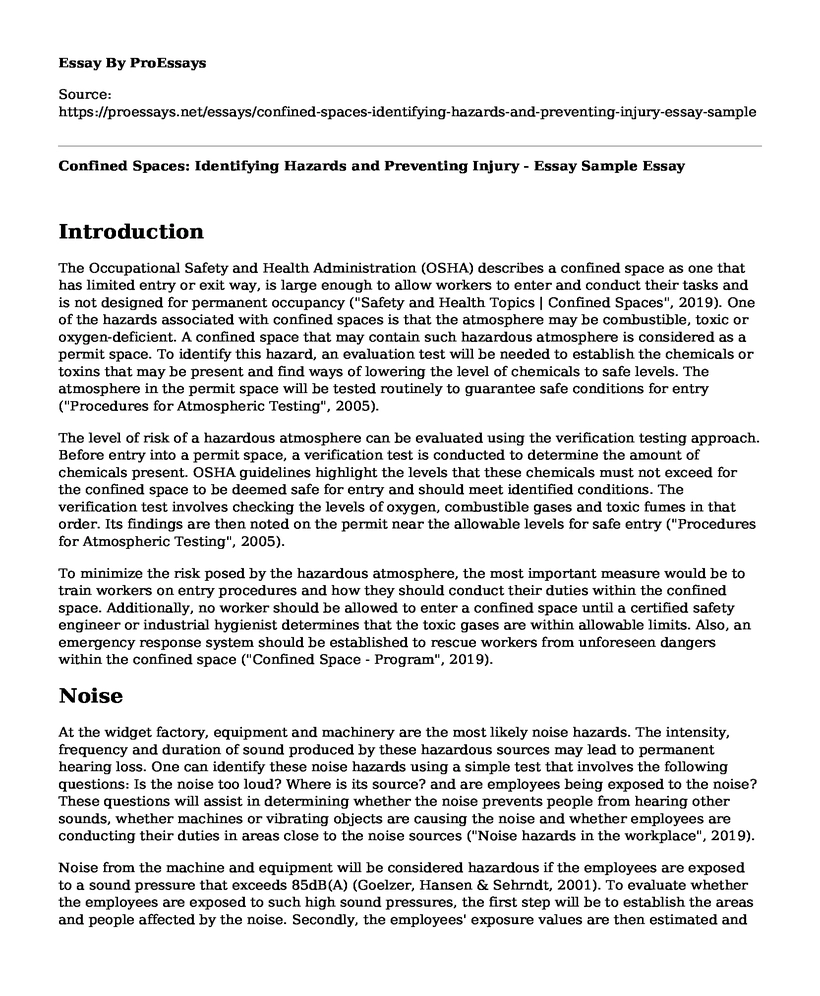Introduction
The Occupational Safety and Health Administration (OSHA) describes a confined space as one that has limited entry or exit way, is large enough to allow workers to enter and conduct their tasks and is not designed for permanent occupancy ("Safety and Health Topics | Confined Spaces", 2019). One of the hazards associated with confined spaces is that the atmosphere may be combustible, toxic or oxygen-deficient. A confined space that may contain such hazardous atmosphere is considered as a permit space. To identify this hazard, an evaluation test will be needed to establish the chemicals or toxins that may be present and find ways of lowering the level of chemicals to safe levels. The atmosphere in the permit space will be tested routinely to guarantee safe conditions for entry ("Procedures for Atmospheric Testing", 2005).
The level of risk of a hazardous atmosphere can be evaluated using the verification testing approach. Before entry into a permit space, a verification test is conducted to determine the amount of chemicals present. OSHA guidelines highlight the levels that these chemicals must not exceed for the confined space to be deemed safe for entry and should meet identified conditions. The verification test involves checking the levels of oxygen, combustible gases and toxic fumes in that order. Its findings are then noted on the permit near the allowable levels for safe entry ("Procedures for Atmospheric Testing", 2005).
To minimize the risk posed by the hazardous atmosphere, the most important measure would be to train workers on entry procedures and how they should conduct their duties within the confined space. Additionally, no worker should be allowed to enter a confined space until a certified safety engineer or industrial hygienist determines that the toxic gases are within allowable limits. Also, an emergency response system should be established to rescue workers from unforeseen dangers within the confined space ("Confined Space - Program", 2019).
Noise
At the widget factory, equipment and machinery are the most likely noise hazards. The intensity, frequency and duration of sound produced by these hazardous sources may lead to permanent hearing loss. One can identify these noise hazards using a simple test that involves the following questions: Is the noise too loud? Where is its source? and are employees being exposed to the noise? These questions will assist in determining whether the noise prevents people from hearing other sounds, whether machines or vibrating objects are causing the noise and whether employees are conducting their duties in areas close to the noise sources ("Noise hazards in the workplace", 2019).
Noise from the machine and equipment will be considered hazardous if the employees are exposed to a sound pressure that exceeds 85dB(A) (Goelzer, Hansen & Sehrndt, 2001). To evaluate whether the employees are exposed to such high sound pressures, the first step will be to establish the areas and people affected by the noise. Secondly, the employees' exposure values are then estimated and compared with the above limit value. Values below 85dB(A) are considered to be level 1, between 85 and 90dB(A) are in level 2 while those above 90dB(A) are in level 3 of the risk scale (Goelzer, Hansen & Sehrndt, 2001).
Having evaluated the risk levels, the recommended control measures to mitigate these noise hazards will aim at regulating the noise source, limiting noise propagation and protecting employees from high sound pressure levels. To regulate the noise source, Goelzer, Hansen and Sehrndt (2001) stated that it is advisable that the machine and equipment are serviced regularly or the factory can opt to purchase quieter equipment. Within the workplace, acoustic treatment or noise enclosures would impede noise propagation. Lastly, for the employees, audiometry tests should be conducted regularly to determine how well they can hear. Based on the results, the safety engineer can design employees' education and work practices to guide workers on how to protect themselves from hazardous noise.
References
Confined Space - Program. (2019). Retrieved from https://www.ccohs.ca/oshanswers/hsprograms/confinedspace_program.html
Goelzer, B., Hansen, C. H., & Sehrndt, G. (2001). Occupational exposure to noise: evaluation, prevention and control. World Health Organization.Noise hazards in the workplace | WSIB. (2019). Retrieved from https://www.wsib.ca/en/noise-hazards-workplace
Procedures for Atmospheric Testing in Confined Spaces. (2005). Retrieved from https://www.osha.gov/OshDoc/data_Hurricane_Facts/atmospheric_test_confined.pdf
Safety and Health Topics | Confined Spaces | Occupational Safety and Health Administration. (2019). Retrieved from https://www.osha.gov/SLTC/confinedspaces/
Cite this page
Confined Spaces: Identifying Hazards and Preventing Injury - Essay Sample. (2023, Feb 20). Retrieved from https://proessays.net/essays/confined-spaces-identifying-hazards-and-preventing-injury-essay-sample
If you are the original author of this essay and no longer wish to have it published on the ProEssays website, please click below to request its removal:
- And the Band Played On: Nursing Policy Development Essay
- Food Matters - Essay Sample
- Essay Sample on Aboriginal Health and Cultural Safety
- Paper Example on Marjorie's Diet Plan: A Financial Guide for Healthy Living
- Essay Example on US Flu Surveillance Data Unreliable: Estimates Used Instead of Cases
- Paper Sample on Maximizing Revenue Cycle Performance: A Critical Factor for Hospitals
- Free Essay Example on Social Engineering and how it applies to Coronavirus Pandemic







